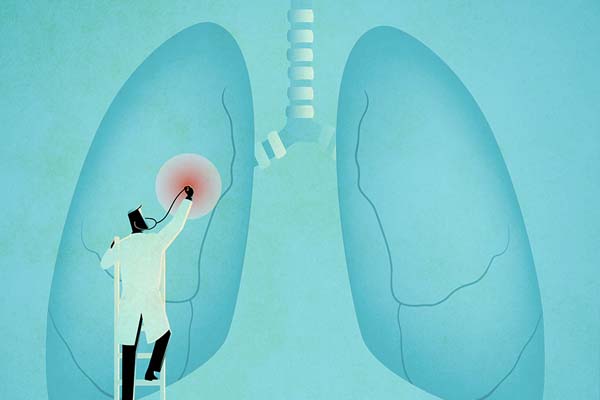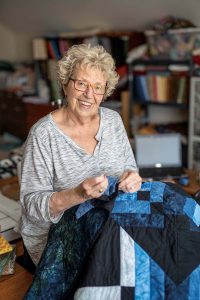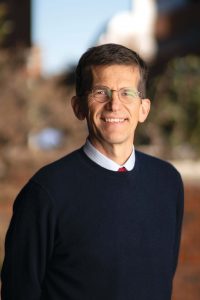A Clear Goal
Action plan addresses rampant lung cancer mortality
January 15, 2020 | Tom Wilemon

Illustration by iStock/Diana Duren
Living at the epicenter of the region with the nation’s highest lung cancer mortality rates, Sallie Sawyer of Gladeville, Tennessee, smoked for 50 years and has evaded death twice.
She participated in a clinical trial for the early detection of lung cancer, which led to her first tumor being discovered when it was just a small nodule. After the cancer returned three years later, she benefited from an immunotherapy that put the disease into remission.
Sawyer is a cancer survivor because her home is only an hour’s drive from Vanderbilt-Ingram Cancer Center, where researchers have set standards for lung screening protocols and launched new therapies that have dramatically improved survival. The researchers now face the challenge of replicating those advancements throughout the multistate region surrounding Nashville.
Kentucky has the nation’s highest death rate from lung cancer, followed by Mississippi and Tennessee, according to the U.S. Centers for Disease Control and Prevention (CDC). The disparity worsens as the interstates leading from Nashville narrow into two-lane highways that wind along Appalachian hills and split through flat farmlands. It’s a region where at least one of every five adults smokes. In Kentucky, smoking is even more prevalent with one out of every four adults lighting up.
“In this region, we suffer from a higher prevalence of lung cancer, and we have a higher mortality rate,” said Pierre Massion, MD, Cornelius Vanderbilt Chair in Medicine and co-leader of Cancer Health Outcomes and Control Research Program. “It is about 30% higher than the national averages. The incidence of lung cancer and the rates of cancer deaths are higher in rural areas where access to screening is not as common. We realize this here at Vanderbilt-Ingram, and we are trying to not only improve the implementation of lung cancer screening as a practice, but also we want to focus on areas at utmost risk.”
Screening protocols established
Sawyer met Massion in 2011 when he was running a clinical trial to determine whether lung screenings of longtime smokers could lessen mortality. She heard an advertisement about the trial and decided to participate.
“At that time, I was still smoking, and I loved my cigarettes and I didn’t want to quit,” she said. “I thought that if I could get in this clinical trial, they would be watching me and catch any cancer early.”

Sallie Sawyer underwent chemotherapy and radiation before she began receiving infusions of the immunotherapy, durvalumab. The tumors are now gone. To express her gratitude, she created a quilt for her physician, Pierre Massion, MD. Photo by John Russell.
Surveillance has been shown to reduce lung cancer deaths by 20% in patients who were at high risk but had no symptoms of the disease.
Sawyer’s screenings were clear until 2015 when her first tumor was found. She quit smoking and underwent surgery for lung cancer on Jan. 25, 2016. Then, two years later, she coughed up blood. She called Massion, who told her to go to the emergency room with an overnight bag and undergo testing. The tests showed that the cancer had metastasized to her lymph nodes and brain.
“I have had very few patients in my experience with lung cancer screening who have recurred after surgery,” Massion said.
Sawyer underwent chemotherapy and radiation before she began receiving infusions of the immunotherapy drug, durvalumab. The tumors are now gone. To express her gratitude, she made Massion a bright blue quilt with a big star pattern.
Handmade quilts get passed down from generation to generation in the Southeastern U.S., where many people have fond memories of watching tobacco leaves grow big and green each summer then appreciating their aroma as the leaves turn golden brown in curing barns each autumn. The rural areas where smoking-related lung cancer is most deadly are dotted with barns and squared into field crops — a landscape that presents an additional challenge for early diagnoses.
Children who played in those barns and adults who tilled the soil inhaled fungal spores that cause histoplasmosis, a lung infection that can leave cancer-mimicking lesions in the lungs. These lesions can result in false positive readings for lung cancer, setting up the possible scenario for unnecessary diagnostic surgeries.
“The tools that we have are good for finding cancer,” said clinical epidemiologist Stephen Deppen, PhD, assistant professor of Thoracic Surgery. “They are not good for ruling out benign disease.”
He and a team of Vanderbilt investigators are addressing this quandary. Their research has resulted in the CDC updating its maps for where histoplasmosis is prevalent. Their research has also provided evidence that a new blood test for histoplasmosis antibodies shows promise as a diagnostic tool for distinguishing cancer tumors from benign nodules caused by the fungal infection. In December 2018 the CDC expanded its maps for histoplasmosis exposure to include the upper Missouri River basin after the research team showed that high rates of the fungal infection existed there as well as in the previously identified Ohio and lower Mississippi River basins.
Racial disparity revealed
Vanderbilt researchers have also investigated whether disparities existed with the lung screening protocols adopted in 2013 for longtime smokers. They determined that the U.S. Preventive Services Task Force (USPSTF) guidelines that determine which smokers qualify for insurance coverage for CT scans exclude significant numbers of African Americans who develop lung cancer.
“Among smokers diagnosed with lung cancer, 32% of African Americans versus 56% of whites were eligible for screening, so it’s a striking disparity in eligibility,” said Melinda Aldrich, PhD, MPH, assistant professor of Thoracic Surgery and the study’s lead author.
The study published June 27, 2019, in JAMA Oncology reviewed cancer incidence data on 48,364 smokers from the Southern Community Cohort Study. Aldrich and fellow researchers concluded that the current USPSTF guidelines may be too conservative for African Americans, setting the stage for later diagnoses and reduced odds for survival.

Pierre Massion, MD, is working to improve lung cancer screening for those at highest risk. Photo by Joe Howell.
The guidelines, which insurance companies follow in determining coverage for CT scans, are based on smoking history and age. However, studies have shown that African Americans have a higher risk of lung cancer than whites even if they smoke less over time. The USPSTF guidelines currently recommend screenings for smokers ages 55 to 80 who have a 30 pack-year history and who still smoke or have within the past 15 years.
The pack-year measurement is based on smoking a pack a day for one year and can be adjusted accordingly if someone smokes less or more than that amount. For example, if someone smoked half a pack for 30 years, the smoking history would equal 15 pack-years.
The researchers calculated that lowering the threshold for African Americans to a minimum 20 pack-year history increased their eligibility and resulted in more equitable screening eligibility.
“This is a proposal for a first step, acknowledging that the guidelines are inadequate — woefully inadequate, actually, as they exist right now — with a suggested change that would largely correct the disparity,” said William Blot, PhD, associate director of Population Science Research at Vanderbilt-Ingram, research professor of Medicine and Ingram Professor of Cancer Research.
The study also noted that the mean age for lung cancer diagnosis occurs significantly earlier in African Americans compared to whites. Modifying the minimum age for African Americans from 55 to 50 would increase their eligibility percentage.
Immunotherapies launched
Vanderbilt researchers have led clinical trials resulting in approvals of new targeted therapies and immunotherapies. The most recent example is the March 18, 2019, decision by the U.S. Food and Drug Administration to approve atezolizumab in combination with chemotherapy for the first-line treatment of adult patients with extensive-stage small cell lung cancer.
It is the first new treatment approved in decades for this particularly aggressive form of lung cancer. The FDA approval was based on the Impower133 clinical trial, the results of which were published Dec. 6, 2018, in The New England Journal of Medicine. The study’s lead author is Leora Horn, MD, MSc, Ingram Associate Professor of Cancer Research and clinical director of Thoracic Oncology at Vanderbilt-Ingram.
“This is the first positive study for immunotherapy with chemotherapy in small-cell lung cancer,” Horn said. “It is actually the first positive study in small-cell lung cancer — for a first-line treatment — in three decades.”
Horn is also one of the investigators for KEYNOTE-001, the longest follow-up study to date of people with advanced non-small cell lung cancer treated with another immunotherapy, pembrolizumab. The results, presented at the 2019 ASCO Annual Meeting, showed a marked improvement over five-year survival rates in the pre-immunotherapy era, which averaged only 5.5%. Pembrolizumab increased the survival rate to 23.2% after five years in people with advanced non-small cell lung cancer who had not previously been treated with chemotherapy and to 15.5% in those who had previously been treated with chemotherapy.
Smoking cessation personalized
While new treatments are prolonging life for people diagnosed with advanced lung cancer, prevention efforts are key to lowering the mortality rate. Most lung cancers are associated with smoking.
Sallie Sawyer was hedging her bets when she entered a clinical trial to evaluate the benefits of lung screening. She wanted to be closely monitored for lung cancer while continuing to smoke. When she was diagnosed four years later, she put down her cigarettes for good.
“It wasn’t hard because I had such a good reason to quit,” Sawyer said. “I had to quit two weeks before the surgery. I quit Christmas Eve of 2015.”
Others struggle with giving up tobacco and nicotine. Patients admitted to Vanderbilt University Medical Center who smoke are offered help through the Tobacco Treatment Service. So are those who undergo lung cancer screening.
Patients with any type of cancer who smoke are particularly at risk, said Hilary Tindle, MD, MPH, the William Anderson Spickard, Jr., MD Professor of Medicine and director of the Vanderbilt Center for Tobacco, Addiction and Lifestyle (ViTAL).
“Smoking not only contributes to the development of lung and other cancers, but also reduces survivorship and increases risk for secondary cancer related to smoking,” Tindle said. “The 2014 Surgeon General’s Report on Smoking identifies at least 15 types of cancer casually linked to smoking. Even for cancers that are not traditionally recognized as being ‘caused’ by smoking, such as prostate cancer, smoking is associated with a higher risk of advanced-stage disease, disease progression and death as compared to non smokers.”
Vanderbilt pioneered personalized care for smoking cessation in November 2018 when the VUMC Tobacco Treatment Clinic began using biomarkers to guide medication decisions in a clinical population. A nicotine metabolite ratio (NMR) test that shows how fast a patient breaks down nicotine. If the patient’s NMR is slow, the medication provided is nicotine replacement. If the patient’s NMR is fast, the medication is varenicline.
Patients who can’t afford prescriptions are provided the medicines for free.
“Abstinence rates for patients who try to quit without help can be as low as 5%, whereas those who use medications are closer to 20% or higher, and adding counseling can further increase quit rates,” Tindle said.
Location is another barrier to care, especially for people in rural areas.
“Many patients travel a long way to receive their care at Vanderbilt,” Tindle said. “With phone consults, we are able to assist patients who may not live close to Nashville. For those who live in Tennessee and are otherwise eligible, we have a limited supply of varenicline donated from the manufacturer and can ship this medication to them for free. The clinic also refers patients to the state quit line in their state of residence.”
On the policy front, Tindle is consulting with Tennessee sate officials, health associations and others about efforts to raise the age to purchase nicotine-related products from 18 to 21.
Next steps envisioned
Sawyer first tried cigarettes in high school, then developed a daily habit at age 18. She’s grateful she can still enjoy life after two bouts with lung cancer.
“I’ve had such good doctors,” she said. “Dr. Massion got me the best he could find when I needed a surgeon or another type of specialist at Vanderbilt. I will never forget him.”
The high cancer mortality rate in the region causes both frustration and concern for Massion, who has a wish list of interventions. Now that he and other Vanderbilt researchers have established best practices for lung cancer screenings and helped usher in a new era for care with new, life-prolonging treatments, they want to make sure people benefit regardless of how far they live from an NCI-designated Comprehensive Cancer Center.
“The first thing we have to do is improve the implementation of lung cancer screening,” he said. “There are barriers to screenings. The barriers can be at the patient level; most people at risk feel healthy and think why would they benefit from screening? There are barriers related to providers’ knowledge and medical systems that are in place. Screening centers need to be accessible and should be accompanied by a smoking cessation program. And there needs to be continuity. Screening is not one test. It is a long-term surveillance program.”
Smokers who undergo lung screening at Vanderbilt are offered counseling and care for smoking cessation. Massion would like for as many hospitals as possible in the region to offer similar programs and make the public aware of them. A starting point of that effort is promoting the programs through the Vanderbilt Health Affiliated Network, a collaborative alliance to enhance care, contain medical costs and improve the health of people in Tennessee and surrounding states.
He and colleagues at Vanderbilt, including Aldrich, Kim Sandler, MD, co-director of the Vanderbilt Lung Screening Program, and Madan Jagasia, MBBS, MS, MMHC, chief medical officer of Vanderbilt-Ingram and holder of the Beverly and George Rawlings Directorship, have envisioned a care model that would extend beyond hospitals.
“We want to reach the underserved populations including in rural areas,” Massion said. “We are designing strategies to get there. We are having discussions to try to bring lung screening to rural communities by means of a mobile scanner on a bus that would be parked at grocery store, drugstore or church and incentivize patients to be screened locally. The positive screens would be managed and followed through in collaboration with their primary care providers, wherever they live.
“Setting up this type of infrastructure is a big enterprise, but, at the same time, it would benefit the people who need it the most.”
